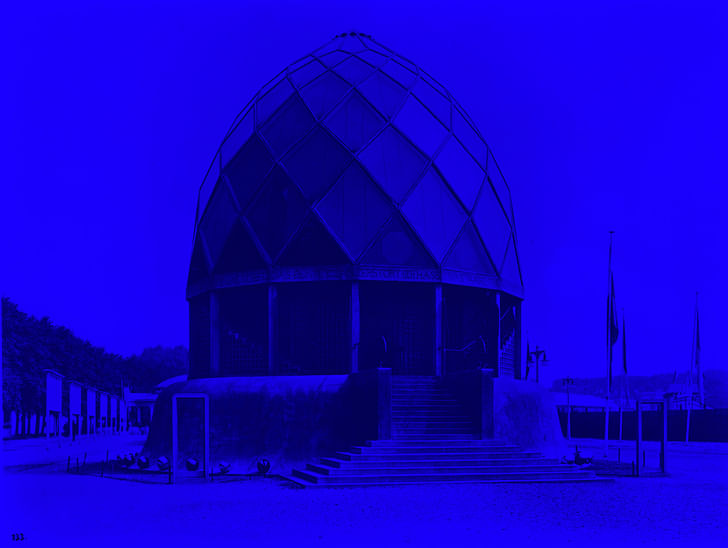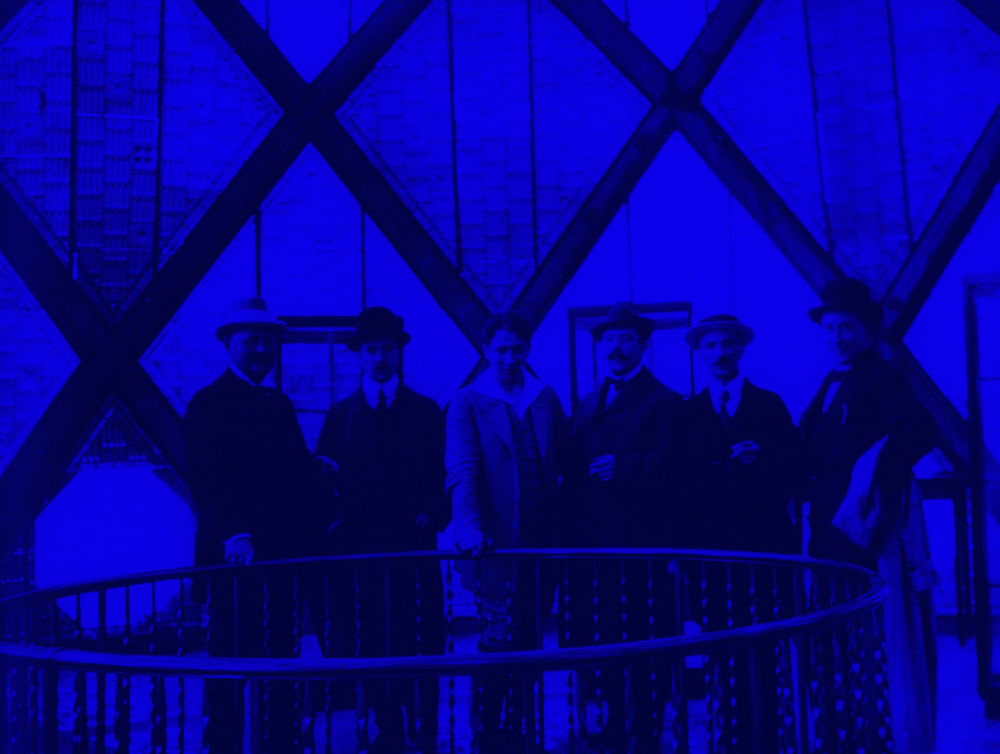

It seems to me unquestionable that an anti-capitalist world—a society that emphasizes process over product, lived experience over representations—would look very different from the one we currently inhabit. The distinguishing characteristics of that world are more difficult to determine. In what way would a historically unique organization of labor yield a correspondingly unique architecture?
One could look toward Stalinist architecture or Russian Constructivism for clues into the organization of space beyond the constraints of capital; yet in doing so we’re encumbered by the fact that neither Stalin nor Lenin lived in a truly emancipated society. At most, the spaces created by way of Stalinist architecture were indicative of a certain “Soviet” ideology, while the formal intuitions of Constructivism easily dissipate into abstraction.
Looking for intimations of an architectural environment not structured by capital, one should probably attend less to the form of production than to its content, its materials. In a world less atomized, in a society that freely and knowingly creates itself, production will become transparent, so perhaps the materials used to sustain production will also become transparent. This is the kind of society anticipated by Paul Scheerbart, whose 1914 essay Glass Architecture postulates a mobile city made entirely of glass. To truly see the value of Scheerbart’s vision as a species of anti-capitalist architecture, however, it must be contextualized as a kind of hyper-capitalist environment that spills over into its opposite, readying the emergence of a self-governing society on the foundation of new spatial relations.

Glass Architecture opens with a profoundly simple spatial insight. “We live for the most part within enclosed spaces. These form the environment from which our culture grows. Our culture is a product of our architecture. If we wish to raise our culture to a higher level, we are forced to transform our architecture.” By seeking to “remove the enclosed quality from the spaces within which we live,” and in viewing this removal as as culturally transformative, Scheerbart hints at a seemingly boundless space that would allow our collective interdependence to become apparent. If built, a Scheerbart structure would let “sunlight and the light of the moon and stars into our rooms not merely through a few windows, but simultaneously through the greatest possible number of walls that are made entirely of...coloured glass.” The limpidity of glass would bring us into closer proximity with entities that are presently known only at a distance through scientific inference. For Scheerbart, glass architecture isn't designed so that we might understand space, but that we might experience it more fully.Our culture is a product of our architecture. If we wish to raise our culture to a higher level, we are forced to transform our architecture.
One would think that in a society where glass is extolled as the non plus ultra of openness, where limpidity is intended to become the very basis of lived experience, providing a foundation for the progress of culture, that the commodity form would of itself be abolished. Yet in Scheerbart, the commodity is no more done away with than the division of labor. Throughout Scheerbart's thinking, finances and pricing go unchallenged. The architect is an artisan-cum-industrialist who is hired by clients. “[It] would simply he necessary for the client to bear the cost and not come to the end of his financial resources too quickly.” Scheerbart gives no contingency plan should the client run out of resources. (Indeed, the client only can run out of resources because scarcity still dominates the acquisition of materials.) Scheerbart also fetishizes the branding of glass. “Tiffany plays a great part in America," he says, and in the next breath, "it would be very interesting to know what is planned in glass for the World Exhibition of 1915 in San Francisco.” The Marxist will read these words and think of nothing else than the commodity-form. To the extent that Scheerbart allows commodities to enter into his architecture, his vision becomes less political than ideological. What transpires is exactly what happens via advertising, branding, and ideology of every kind. Glass, far from abolishing the social relationships dictated by the commodity, transforms space itself in an industry.

But this is where social relationships governed by commodity production are replaced by an emphasis on production itself. Much of what Scheerbart claims is the virtue of glass architecture, and the culture that comes out of it, is, in fact, derived from an appreciation for history. Rather than celebrate a historically isolated modernity with no connection to the past, Scheerbart discovers continuity between architecture that has existed and the glass architecture to come. He speaks of monumental palaces where “the best architects should devote themselves particularly to entrance-hall...and then invite the interior designers to surpass the complicated architectonic effects.”
Scheerbart discovers continuity between architecture that has existed and the glass architecture to come
Scheerbart’s attraction to the monumental coincided with the then-emerging construction of highrises and Glass Architecture could be said to anticipate a building like the Burj Khalifa. The main difference, however, is that a structure like the Burj Khalifa feigns transparency, while actually concealing what goes on within it. Such a structure could be said to lend itself to exploitative relationships. Scheerbart, by contrast, seems to look forward to a society founded on genuinely transparent labor. Opposed to the opacity of brick, a city of glass “would be as splendid as in the gardens of the Arabian Nights. We should then have a paradise on earth, and no need to watch in longing expectation for the paradise in heaven.”
The allure of the architectural program Scheerbart sets out to realize lies in its emphasis on transparency, clarity, and mobility. By way of the unique spatial relationships glass architecture realizes, industry will come to exist for the sake of architecture, not the other way around. “The introduction of iron into house-building will, beyond question, bring so many new orders to heavy industry that it could continue to exist even if all cannon-making were stopped.” This overtly pacifist position is supplemented by new labor relations that circumvent state-sanctioned appointments in favor of voluntary, client-based relationships. “When the state wants to build, government architects are at its disposal—not the best architects, who are generally freelancers. This is a deplorable situation, and it is the state that one chiefly deplores. These official architects, who are always hamstrung by bureaucracy (hence their inhibitions and conservatism), must once again become free; otherwise they will hinder future architectural progress.” While Scheerbart does not overtly claim to lay the groundwork for an anti-capitalist society, the “new culture” his glass architecture would introduce might compel architects to turn against bureaucracy and the state.

The world Scheerbart aspires to, using glass as his medium, is alterity incarnated. Living through glass, contemplating its translucency, we become closer to what today exists for us only remotely, separated by distance or history. As one commentator notes, Scheerbart’s Glass Architecture “is not about seeing beyond, it’s about being illuminated in the space that one is in now.” As I hoped to have sketched, this emphasis on the now, on the experience of light, coloration, and monumental architectures of history, is a dialectical point where Scheerbart both continues and deviates from capitalist production. There’s still money and property, but the relationship of worker to boss is abrogated. Glass Architecture suggests that if the materials of our manufacture were altered, if they could somehow not congeal so easily into opaque objects, then the social relationships governed by the commodity would be eradicated.
Jeffrey Grunthaner is a writer and curator based in Brooklyn. Recent articles, reviews, poems and essays have appeared via Drag City Books, Folder, Hyperallergic, Whitehot Magazine of Contemporary Art, BOMB, and Imperial Matters. His most recent curatorial project Sight | Site ...
3 Comments
'As one commentator notes, Scheerbart’s Glass Architecture “is not about seeing beyond, it’s about being illuminated in the space that one is in now.” '
Yoga. Being present. Glass as a way of seeing other places and things so you understand where and who you are.
Every step taken toward the horizon is one step closer to home.
It's weird that you didn't mention Bruno Taut, the architect of these images. Taut used some of SBs ideas to influence Gropius, which is interesting if you read early Bauhaus history which is kind of a road not taken--a more organic, mystical reaction to the technology of the day..(like a Steven Holl). And yet the transparency, glass stuff was carried on with Gropius in a bloodless, functionalist way... without the mysticism, and fun of "colored glass destroys hate."
Reminds me of how Smart Cities technocrats take "transparency" and "functionalism" and twists it into a narrative rather than an architecture utopia.
The politics of SB seem more tied to their day, almost a-political in a way. Though Bauhaus modernism was clearly a leftist regime (transparent socialist buildings as data), while postmodernism a far-right reaction (opaque, hall of mirrors imagery, i.e. Dictator-chic)
excellent critical analysis of Scheerbart’s Glass Architecture but it focuses too much on the past - the next step might look to the present and the future and engage with the emerging literature on 'iconic architecture' and 'starchitects' and their connections with glass, shiny metals, and commodification. These often derided ideas are not architectural, but sociological concepts, as I try to analyse in my new book The Icon Project: Architecture, cities, and capitalist globalization (New York: Oxford University Press, 2017).
Block this user
Are you sure you want to block this user and hide all related comments throughout the site?
Archinect
This is your first comment on Archinect. Your comment will be visible once approved.